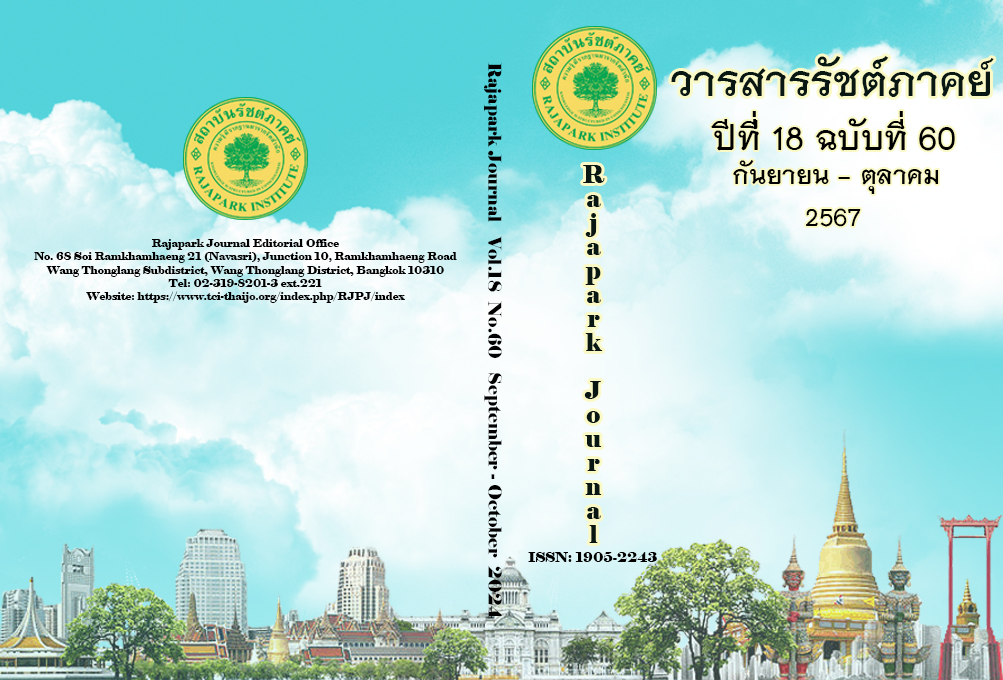The Relationship Between Offender and Victim Rights: A Case Study of Juvenile Involvement in Armed Groups
Main Article Content
Abstract
This article is part of a thesis on Children's Rights in the Context of Violence in the Southern Border Provinces Region of Thailand: A Case Study of Children at Risk of Joining Armed Groups. The legal status of children involved in, and at risk of joining, armed groups is analyzed. The question examined is whether children engaged in armed groups should be attributed the status of offender or crime victim, insofar as children so involved may later commit crimes as offenders. In addition to studying action and its consequences, this article offers a retrospective look at the origins of juvenile involvement in armed groups. Results show that children involved in armed groups and assigned to perform actions have been abused by the groups because enlistment or solicitation of children is a crime under international law. Children involved in armed groups have two overlapping statuses: offenders and crime victims, each of which affects their entitlements differently. From the issue of determining the status of children involved in such armed groups internationally, a central basis for assessing the status of such children should be considered a dual identity with undefined status, with one status solely attributed to the child.
Article Details

This work is licensed under a Creative Commons Attribution-NonCommercial-NoDerivatives 4.0 International License.
Views and opinions appearing in the Journal it is the responsibility of the author of the article, and does not constitute the view and responsibility of the editorial team.
References
Hartinger-Saunders, R.M. (2008). The history of defining youth: current implications for identifying and treating delinquent youth. The New York Sociologist, 3. 87-90. http://newyorksociologist.org/08/Hartinger-08.pdf
Hengtragoon, K. (2012). Adolescents: Young criminals and crime victims. Journal of Thai Justice System, 5(2), 15–21. https://so04.tci-thaijo.org/index.php/JTJS/article/view/246000
ICRC. (2020, February 3). From children conscripted into soldiers to “terrorist children”: Protecting the rights of innocence from the anti-terrorism process. ICRC blog Thailand. https://blogs.icrc.org/th/2020/02/03/from-child-soldier-to-child-terrorist-safeguarding-innocence-from-counter-terrorism/
Khantasak, F. (2014). Causes of juvenile delinquency and juvenile court proceedings According to the Juvenile and Family Court and Procedure Act B.E. 2010. Office of the Prosecutor for Juvenile and Family Cases, Yala Province.
Østby, G., Siri, A. R., & Andreas, F.T. (2020). Children affected by armed conflict, 1990-2019. Conflict Trends, 6. Oslo: PRIO. https://www.prio.org/publications/12527
Rosen, D.M. (2007). Child soldiers, international humanitarian law, and the globalization of childhood. American Anthropologist, 109(2), 296-306. https://doi.org/10.1525/aa.2007.109.2.296
Singlor, T. (2021, December 3). Child soldiers' are the worst form of child labor. But worldwide, 1 in 8 children in war zones are at risk of being drafted. SDG MOVE. https://www.sdgmove.com/2021/12/03/1-in-8-children-child-soldiers-worst-form-child-labours/
Whitman, S., Zayed, T., Conradi, C., & Breau, J. (2012). Child soldiers: A handbook for security sector actors. The Roméo Dallaire Child Soldiers Initiative, Centre for Foreign Policy Studies, Dalhousie University. https://childsoldiers.org/files/handbook.pdf
International Committee of the Red Cross. (2012). Child soldiers and other children associated with armed forces and armed groups. https://www.icrc.org/en/doc/assets/files/other/icrc-002-0824.pdf
United Nations Office on Drugs and Crime (UNODC), and United Nations Children’s Fund (UNICEF). (2015, April). Training programme on the treatment of child victims and child witnesses of crime for prosecutors and judges. https://www.unodc.org/documents/justice-and-prison-reform/Training_Programme_on_the_Treatment_of_Child_Victims_and_Child_Witnesses_of_Crime_-_Prosecutors
_anf_Judges.pdf
United Nations Office on Drugs and Crime (UNODC). (2017). Handbook on children recruited and exploited by terrorist and violent extremist groups: The role of the justice system. https://www.unodc.org/documents/justice-and-prison-reform/Child-Victims/Handbook_on_Children_Recruited_and_Exploited_by_Terrorist_and_Violent_Extremist_Groups_the_Role_of_the_Justice_System.E.pdf


